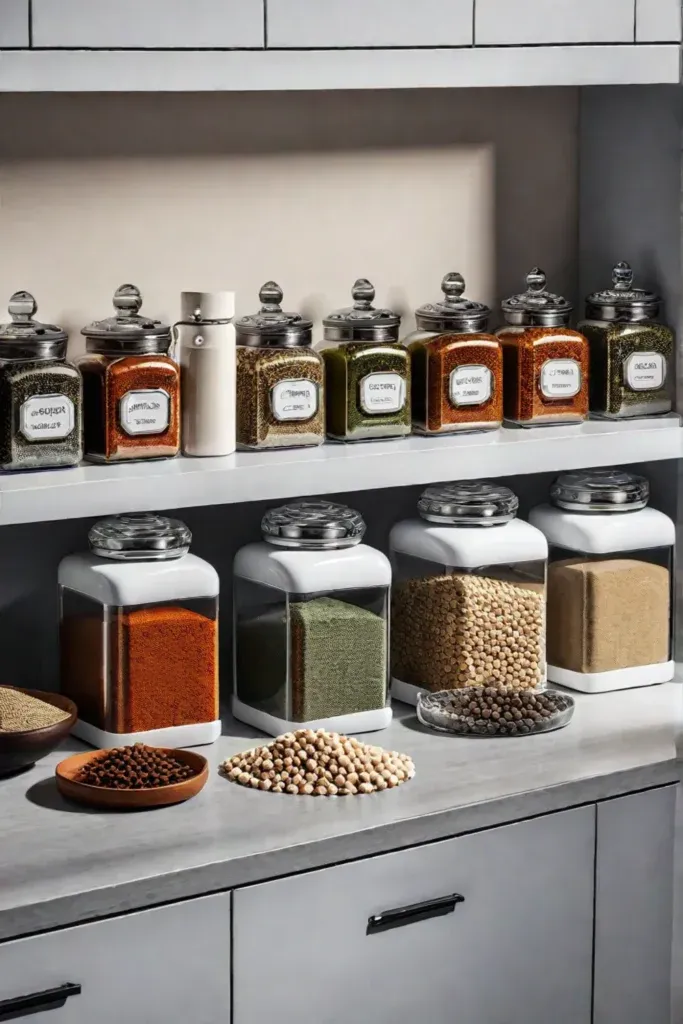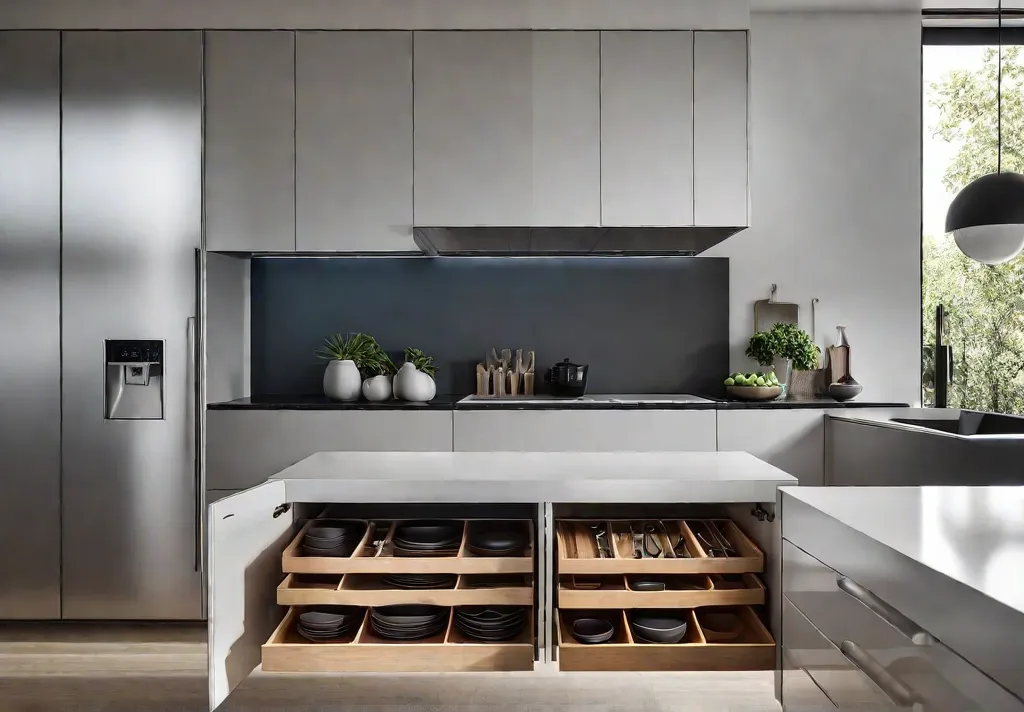As a lifelong design devotee, I’ve always believed that thoughtful organization is the secret to not only creating beautiful living spaces but also cultivating a sense of inner calm. And what better place to start than the kitchen – the heart of the home where form and function converge?
This weekend, join me on a DIY journey that will transform your culinary domain into an oasis of modernist harmony. We’ll tackle everything from wrangling that chaotic junk drawer into an elegant vignette to curating an intentional spice rack system worthy of a gallery exhibit. Along the way, you’ll discover sustainable storage solutions that elevate the every day while staying true to your unique aesthetic.

So grab your label maker, dust off that X-ACTO knife, and get ready to embrace the art of intentional organization. Because when we mindfully impose order on our surroundings, we open the door to a more inspired way of living.
Tackle the Junk Drawer: DIY Drawer Dividers
Are you tired of rummaging through a chaotic jumble every time you need to find something in your kitchen’s catch-all drawer? It’s time to reclaim that space – and your sanity – with a simple DIY project that will transform cluttered chaos into an oasis of order.

The Case for Customized Compartments
Let’s start with the numbers: Studies show the average junk drawer holds a staggering $243 worth of unused and disorganized items. All that wasted potential (not to mention wasted time spent searching) is enough to make any design devotee cringe. The solution? Thoughtfully planned drawer dividers that create designated homes for all your odds and ends.
Sustainable Material Choices
When it comes to DIY drawer organizers, the options are delightfully eco-friendly. Upcycling old cardboard boxes or repurposing budget-friendly materials like foam board align beautifully with modernist principles of utility and conscious living. Don’t just take my word for it – even celebrated visionaries like Ray and Charles Eames embraced humble, unconventional mediums in their boundary-pushing creations.
Measuring for the Perfect Fit
Before you wield your X-ACTO knife, precise measurements are key to maximizing every square inch of drawer space. I recommend sketching a quick diagram noting your drawer’s dimensions, as well as taking stock of which items need dedicated compartments. With these thoughtful considerations, your custom divider system will embody the seamless function that defines truly great design.

The beauty of this project lies in its simplicity and potential for personal expression. Consider covering your dividers with decorative washi tape to inject pops of color, or use old cereal boxes for sturdy, sustainable compartments. Just a few mindful interventions can elevate the mundane and transform something as basic as a junk drawer into an elegant vignette celebrating order and intention.
With your newly organized drawers providing a sense of calm amid the kitchen chaos, you’ll be ready to tackle our next DIY adventure: creating a cohesive spice rack system that brings harmony to your seasoning collection.
Spice Rack Revamp: Creating a Cohesive System
As a design enthusiast, I’ve always been drawn to spaces that effortlessly blend form and function. And what better place to start cultivating this harmony than in the heart of the home – the kitchen? Spices are the unsung heroes that transform simple ingredients into culinary masterpieces, so why not give them a stage worthy of their importance?

Choosing the Right Spice Jars for Your Style and Needs
The first step in creating a cohesive spice rack system is selecting jars that not only look great together but also suit your practical needs. Uniform glass jars with airtight lids are a timeless choice, allowing you to see the vibrant colors and textures of the spices within. For a more organic vibe, consider ceramic or wooden containers with a minimalist silhouette.
Labeling Techniques for Easy Identification
Once you’ve chosen your vessels, it’s time to get labeled. A simple label maker can give your spice rack a polished, uniform look. But for those seeking a more personal touch, try your hand at calligraphy or chalkboard-style labels. Not only will this add character, but it also ensures you can easily identify each spice at a glance – no more mistaking cumin for chili powder!
Organizing for Optimal Flow
Now for the fun part: arranging your spices in a way that not only looks visually appealing but also enhances your cooking experience. Consider grouping them by cuisine, frequency of use, or even alphabetically. Whichever method you choose, make sure the most frequently used spices are within easy reach.

With your spice rack revamped into a functional work of art, it’s time to turn our attention to another oft-neglected area of the kitchen: the under-sink storage.
Under-the-Sink Storage Solutions: Maximizing Vertical Space
Have you ever opened up the cabinet under your kitchen sink and felt overwhelmed by the cluttered mess? It’s a space that often becomes a catchall for cleaning supplies, trash bags, and other household odds and ends. But with a little thoughtful organization, that valuable real estate can be transformed into a functional, streamlined storage solution.

Assessing Your Under-Sink Storage Needs
Before diving into organization mode, take a step back and assess what items need to live in this cabinet. The average under-sink area can hold up to 30% more with proper planning, so be discerning. Cleaning supplies, dishwashing essentials, and perhaps a few tools are ideal candidates. Anything else is just creating unnecessary clutter.
Implementing Vertical Storage Solutions
Now it’s time to maximize that vertical space. Install some tiered shelving or stackable bins to instantly double your usable area. I’m a big fan of clear containers so you can easily see what you have at a glance. For those taller items like spray bottles or brushes, add a tension rod and use S-hooks to hang them up and free precious shelf space.
Don’t forget the interior of the cabinet door itself – that’s prime real estate for hanging storage caddies or a DIY rail system. For those hard-to-reach back corners, a lazy Susan spinner makes accessing everything a breeze.
Containing Leaks and Spills
Of course, an under-sink organization has to account for the risk of leaks and spills. Use waterproof bins and trays to catch any drips or splashes. Place a mat or tray on the cabinet floor as well for added protection. With a little preparation, you can prevent any major cleanup headaches down the road.

With some creative vertical storage solutions, you can bid farewell to that unsightly under-sink clutter for good. A few smart tweaks will not only give you back precious space but also make accessing your household essentials incredibly efficient. Up next is transforming your pantry into an equally streamlined food storage oasis.
Pantry Organization: Creating a Functional Food Storage System
Did you know the average household wastes up to 40% of the food they purchase? An organized pantry is the secret to saving money, reducing waste, and making meal planning a breeze. By thoughtfully curating our food storage spaces, we can elevate the simple act of cooking into an inspiring experience.

Decanting and Labeling Pantry Staples
The first step in cultivating a functional pantry is decanting dry goods into clear, airtight containers. This not only creates a cohesive aesthetic, but allows you to easily see when supplies are running low. I recommend investing in some high-quality glass jars or canisters – their clean lines beautifully showcase the organic textures of ingredients like rice, lentils, and pasta.
Once decanted, meticulously label each container using chalk markers or printable labels. This simple act transforms a basic canister into a modern design object while ensuring you can effortlessly identify contents at a glance. Consistent labeling is key to an organized system.
Utilizing Storage Containers and Organizers
With staples decanted, it’s time to impose order on the rest of the pantry using a variety of storage solutions. Clear plastic bins are ideal for corralling snacks – they satisfy the need for visibility while containing any crumbs or spills. I especially love vintage Pyrex containers repurposed for this use – the colored lids add lovely pops of color.
Don’t overlook vertical space either. Installing some simple shelving units or risers allows you to double your storage capacity. Baskets are perfect for housing oddly shaped items on these shelves. The natural textures provide beautiful textural contrast.

Ultimately, the goal is to ensure every item has a designated “home” in your pantry system. This not only looks impeccably curated but prevents futile digging expeditions when you need to quickly locate ingredients.
With a few thoughtful interventions, the humble pantry becomes a shining example of how good design principles can elevate even the most mundane spaces into something extraordinary.
Upcycling old items is next on our agenda – it’s one of my favorite ways to inject vintage soul into modern living spaces.
Upcycled Kitchen Storage: Giving New Life to Old Items
Have you ever looked around your kitchen and felt overwhelmed by the clutter of mismatched containers and storage pieces? What if I told you that the solution to your organizational woes might be hidden in plain sight – in the form of everyday household items just waiting to be repurposed? Welcome to the world of upcycling, where trash becomes a treasure and sustainability meets style.

Creative Upcycling Ideas for Kitchen Storage
The beauty of upcycling lies in its ability to transform the ordinary into the extraordinary. Take something as simple as a mason jar, for instance. With a little imagination, it can become a chic utensil holder, a stylish spice container, or even a trendy bulk food storage solution. And let’s not forget about those old crates gathering dust in the garage – they make fantastic open shelving units or magazine racks that add a rustic touch to your kitchen.
Decorating and Personalizing Your Upcycled Creations
But why stop at functionality when you can also infuse your upcycled pieces with personality? Decorative touches like chalkboard paint or vintage labels can turn a humble tin can into a charming planter for your herb garden. And those old glass bottles you’ve been meaning to recycle? With a little creativity, they can become whimsical vases or even quirky soap dispensers.
Embracing Sustainability and Individuality
Upcycling isn’t just about creating functional storage solutions; it’s also about embracing sustainability and reducing waste. Did you know that repurposing a single glass jar can save enough energy to power a laptop for an hour? By giving new life to items that would otherwise end up in a landfill, you’re doing your part for the environment while adding a unique touch to your kitchen that reflects your style.

So, the next time you’re tempted to toss out that old tin can or glass bottle, pause and consider the possibilities. With a little creativity and a dash of DIY spirit, you can transform these everyday items into personalized, eco-friendly storage solutions that will keep your kitchen organized and stylish. Embrace the art of upcycling and let your kitchen become a reflection of your commitment to sustainability and individuality.
As we bid farewell to the world of upcycled kitchen storage, let’s turn our attention to the concluding thoughts that will leave you inspired to embark on your DIY journey.
Conclusion
Thoughtful organization is about so much more than just tidying up – it’s a way of life that brings beauty and intention into every corner of the home. By embracing simple DIY projects like the ones we’ve explored, you’re not only creating functional storage solutions but crafting an environment that nourishes the soul.

As you step back to admire your handiwork, let the sense of calm wash over you. That’s the power of good design at work – transforming the mundane into the extraordinary. Now go forth and let your newfound organizational enlightenment inspire future projects infused with your unique creative vision.
Because at the end of the day, cultivating a home that seamlessly blends utility and artistry isn’t just about looking good. It’s about elevating the human experience and celebrating the beauty in everyday moments. And really, isn’t that the most modern ideal of all?






